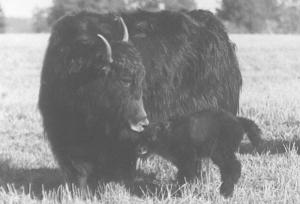2001 - Volume #25, Issue #1, Page #38
[ Sample Stories From This Issue | List of All Stories In This Issue | Print this story
| Read this issue]
Low-Fat Yaks Catching On Fast
 |
Purebred Yaks, which are native to the Himalayas, have only 3% fat and even Yak/beef crosses have just 1/3 the fat of regular beef animals. Yet unlike other low-fat meats, Yak fans claim the Yak meat stays moist and tender.
"Yaks developed at high altitudes where they needed more blood vessels to survive," says Tad Puckett, Crested Butte, Colorado. "As a result, the meat stays more moist than bison, which is also a low fat animal."
Puckett is one of a small number of Yak breeders in North America. He estimates that there are only 1,500 full blood Yaks on the continent. He has around 150 head. McRoberts Game Farm, Gurley, Nebraska, claims more than 600 head.
Some Yak owners keep one or two as novelty pets. Others have found them to be outstanding pack animals in mountain terrain. Still other Yak owners keep them for the fine wool which is exceeded in warmth only by the musk ox. While Puckett sells them for all of those things, it is yak burger that gets him excited.
"I go into restaurants and give the chefs free sample patties and ask them to try it," says Puckett. "I have never yet had anyone say they prefer ground beef to ground Yak. I have four restaurants that buy all I can produce at $3.50/lb."
With 150 head, Puckett could produce more ground Yak if he wanted; however, the live market is pretty good, too. Cows and bulls generally start at $2,000 and go up from there, depending on their breeding line, color, size and disposition.
While Yaks don't get big, generally topping out at under 1,500 lbs., they are easy keepers, growing well on grass and hay. Native wild Yaks developed an ability to survive under barren mountainous conditions, virtually without feed through the winter.
"They have a very slow digestive system that allows them to survive under almost any conditions," says Puckett. "You can feed three Yaks for every beef cow."
Puckett advises customers to breed a good Yak bull to beef cows to gain hybrid vigor in size and growth, yet retain efficiency and end value. He butchers his 1,200 lb crossbreds at two years, though he has produced a Charolaise/Yak that reached 1,500 lbs. at 19 months. Full blooded Yaks are butchered out at three years of age.
"Yaks are one of the few other species that can cross with cattle," explains Puckett. "Although first generation cross males are not fertile, female cross breeds can be bred back to beef or Yak bulls."
Contact FARM SHOW Follow up: Tadd Puckett, Box 535, Crested Butte, Colo. 81224 (ph 970 641-4425; E-mail: gpanddog@crestedbutte.net; Website: www.whiteelkranch.com or www.yakpage.com for the North American Yak Breeders Association).

Click here to download page story appeared in.

Click here to read entire issue
To read the rest of this story, download this issue below or click here to register with your account number.




